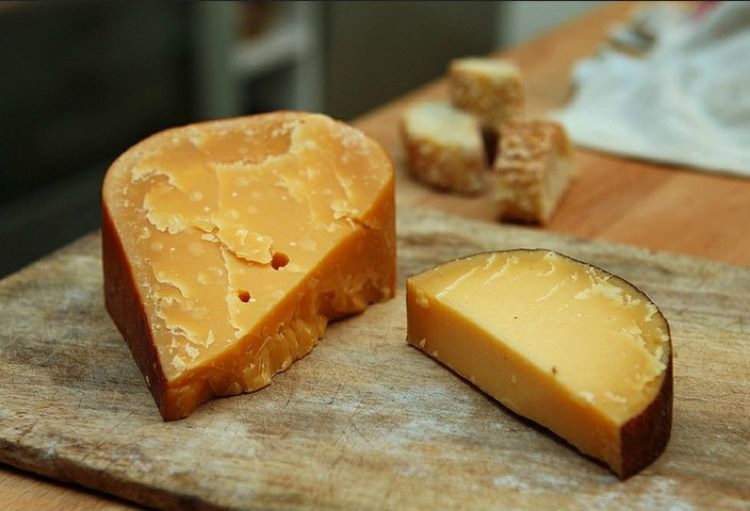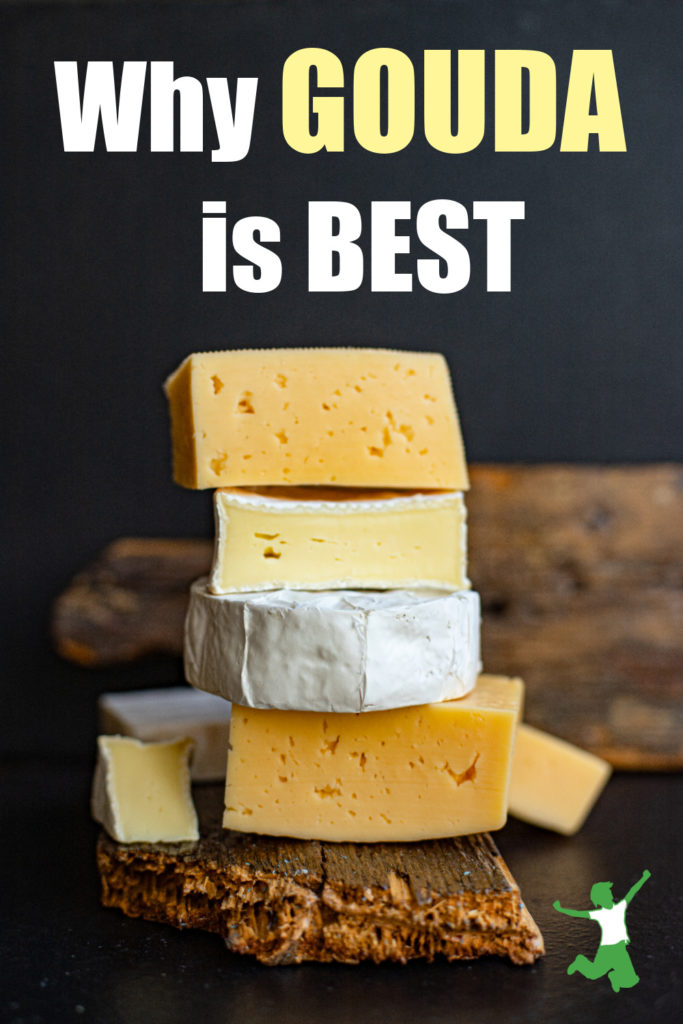Why Gouda is likely the most nutrient dense type of cheese you can buy even if you buy supermarket brands made with conventional milk.

If I was forced to choose a single cheese to eat for the rest of my life that would best maintain my health, it would be Gouda cheese.
Is Gouda my favorite healthy cheese?
Not really.
While I certainly like Gouda cheese and don’t mind eating it, my taste buds consistently rank several other cheeses quite a bit higher on the enjoyment scale such as Brie which I craved during pregnancy.
Why Gouda cheese then?
Gouda and the X Factor
You might be shocked to learn, as I was, that Gouda cheese is higher than most liver, grassfed butter, and even pastured egg yolks in the critical nutrient Vitamin K2.
This is the nutrient identified by Dr. Weston A. Price as the elusive “Activator X”.
Vitamin K2 along with the other fat soluble activators A and D are synergistically responsible for the vibrant health and extremely high resistance to aging and degenerative disease as experienced by Traditional Cultures and as described in Dr. Price’s groundbreaking book Nutrition and Physical Degeneration.
Vitamin K2 is extremely difficult to get sufficient quantities of in the diet. This is the case even if one consumes grassfed meats and dairy on a regular basis.
The reason is the worrisome depletion of our soils which grassfed farmers are valiantly turning the tide on, but which will still take several decades if not even a century or two to reverse on a widespread basis.
On top of this, many families are currently struggling to afford any grassfed meat and dairy at all.
An inflationary economy requires creative and practical solutions for the food budget. This ensures that this critical and elusive nutrient is in the diet in sufficient quantities.
This helps secure freedom from tooth decay and high immunity. Such vigilance prevents degenerative diseases like osteoporosis, cardiovascular disease, periodontal disease, cancer, and diabetes among many others.
K2 is also the vanity vitamin as it is known to prevent facial wrinkles. K2 deficiency can be written all over your face…quite literally!
Synergy with No Toxicity
Vitamin K2 has no known toxicity even at high intake levels.
However, it is most effective when consumed in the presence of the other fat soluble activators Vitamin A and D.
Therefore, getting Vitamin K2 from food is always the best way to go if at all possible.
Gouda Cheese Top 3 for Most Elusive Nutrient
This is where Gouda cheese comes in.
You see, the food that is highest in Vitamin K2 is natto, which is very difficult to find and even more difficult to consume due to its very horrible taste and texture. If you are game, you can usually find it at Asian specialty stores. Look for it in the freezer section.
Natto contains about 1,103 mcg of K2 per 3.5 ounce portion. This is more than any other food by a large margin. Note that it is best to source organic natto due to toxicity issues from GMO soybeans.
The second highest food in Vitamin K2 is goose fat particularly from the liver which has 369 mcg per 3 1/2 ounce portion.
While highly delicious and wonderful to eat, goose liver pate is very hard to find in most places. It is also a very high end, gourmet food which makes the price out of reach for most.
Rounding out the top 3 foods highest in Vitamin K2 is none other than the humble Gouda cheese. It boasts 75 mcg per 3 1/2 ounce serving! This compares to pastured egg yolks and butter, which each have about 15 mcg of K2 per 3 1/2 ounce portion.
Grassfed or Organic Not Required
Here’s the really excellent news…
Gouda cheese is extremely high in Vitamin K2 even if the milk it’s made from was not grassfed.
This is due to the bacterial cultures used to ferment milk into Gouda cheese. Bacteria produce a special type of Vitamin K2 (MK-7) which according to current research is as effective as the animal form of Vitamin K2 (MK-4) at preserving human health when combined in the diet with the other fat soluble activators A and D.
Of course, grassfed Gouda cheese would be best as Gouda made from this highest quality raw milk would be high not only in MK-7 but also MK-4, the animal form of K2.
For some, however, supermarket Gouda cheese is all they can find or afford!
In other words, Gouda cheese is high in Vitamin K2 regardless of how the milk was produced. Gouda even if made from the milk of the average grainfed, conventionally raised cow, is still very much worth it to buy from a nutritional standpoint!
Other hard cheeses would also be high in Vitamin K2, but Gouda is the highest of them all. Perhaps this is a reason why cheese is the most stolen item in the world!
Sources
Vitamin K2 and the Calcium Paradox, by Dr. Kate Rheaume-Bleue ND









I think it’s absolutely ridiculous that the blogosphere has latched onto Gouda as the K2 Silver Bullet of cheeses. And it’s all due to a segment on the Dr. Oz show where a panelist suggested hard cheeses, “such as Gouda,” as a source for K2.
People, do some research and you will find that a lot of other cheeses contain high levels of K2, such as Jarlsberg and emmental.
See http://www.journalofdairyscience.org/article/S0022-0302%2807%2971865-9/fulltext for more information.
Thanks for the interesting link, Joe. It appears that Jarlsberg may have a similar amount of K2 to Gouda, since 75 mcg in 3.5 oz. of Gouda is about 755 ng/g, which is close to the amount in this link showing 796 ng/g in Jarlsberg. Emmental is about half of that. However, Gouda was not tested in this particular study that you cite, so it’s hard to be sure how they compare.
I think you should try to share information, or even offer criticism, in a more courteous manner. The information about Gouda that Sarah and other bloggers have provided us with is accurate. You shouldn’t berate them for not including information from every scientific study that’s been done on every post they make. Are you sure it is all based on a Dr. Oz show? Sarah references Dr. Kate Rheaume-Bleue’s book, not Dr. Oz.
The stats quoted by bloggers might be accurate in some regards, but the bloggers also jump to conclusions and offer suggestions not supported by the original research.
For example, Sarah’s original post advocates Gouda based on a table in Rheaume-Bleue’s book (http://books.google.com/books?id=WqHkmhNZuWcC&dq). However, the research cited by Rheaume-Bleue — “Determination of phylloquinone and menaquinones in food. Effect of food matrix on circulating vitamin K concentrations” (http://www.ncbi.nlm.nih.gov/pubmed/11356998) — never cited Gouda as the hard cheese highest in K2, or Brie as the soft cheese highest in K2.
Rheaume-Bleue simply took a chart from the study and offered examples of types of hard and soft cheeses one should look for, i.e. Gouda and Brie. She never said that these are “the highest” in K2 for their types (see Chapter 3, Ghee and Butter Oil from Grass-Fed Cows, subsection “Two Types of Vitamin K2”).
Sorry for the bluntness and aggressive tone, and apologies to Sarah’s forum for taking the brunt of this. However, when someone Google’s around looking for foods high in K2, they invariably end up at this site. Hopefully, a person or two will see my post and realize that there are many other good alternatives.
P.S. In addition to my cheese intake, I add 5 grams of frozen natto to my morning home-cultured kefir smoothie (Google “Kefir Lady”). Based on the Weston Price numbers, this should give me approx. 55 micrograms of K2 (MK-7) everyday. Five grams of natto in a smoothie is not detectable at all; if you increase the amount, it should be easily masked by more fruit or sweetener of your choice. Also, according to Lifeway Kefir’s website, one serving of kefir contains 300 mcgs of K2. However, I have no idea how much K2 is in my homemade kefir; could be more, could be less…
Nothing wrong pointing out sloppy research. But then again the internet is filled with people rehashing other peoples posts and information without checking it.
Thanks very much for your explanation and your apology, Joe. Also, putting natto in a kefir smoothie is a great idea. I was very interested to know that Lifeway Kefir has 300 mcg K2 as I have read that kefir is a good source of K2 but have not been able to find out how much that might be.
I was very interested in learning about Gouda! Thanks so much for providing us with this information, Sarah!
I have read that kefir is also an excellent source of Vitamin K2. Does Dr. Rheaume-Bleue mention kefir in her book?
What are your suggestions for wrapping or other storage methods for blocks of cheese?
Please don’t talk about natto if you’ve never tried it — my apologies if you have — and even thought it’s tempting to agree with conventional wisdom, authors should not write opinions about things they don’t know about first hand.
I wasted many years avoiding natto because of all the horrible reviews (it’s unanimously considered prohibitively disgusting to Westerners), but then I got a clue and decided to try it for myself. Verdict: It’s not that bad.
Here is my (honest) opinion of natto:
Aroma is deep and rich like strong soy sauce — and here I was expecting a horrible moldy French cheese smell!
Texture is strange like slime, but I prefer to think of it as “stringy”.
The taste is very bland — it needs salt or soy sauce — but then you are hit with a bitterness that’s worse than dandilion. To cover up the bitter taste, it’s good with avocado, and oily rice or noodles.
It’s much better than tempeh in my opinion, which by comparison tastes “fungal” and makes me physically sick.
I have been enjoying my new food, natto, and I intend to alternate natto with a delicious raw gouda from Trader Joe’s. (at a reasonable price)
Also, natto is very available in most Asian markets and very cheap – about $3 for a 3-pack. I wish I could verify that it was GMO-free but that is difficult because I don’t read Japanese.
Hear, hear! We love natto. I put it in with our fried rice and am always tempted to stir in that little mustard packet and just eat it straight outta the container! 😉
Lisa,
Where in Trader Joe’s is RAW Gouda Cheese?
I buy there 1000 day Gouda,. Is that the one your talking about?
From what I was told, T. J’s. cannot sell any Raw Dairy, and they do not.
I’ve managed to locate a source of matured Dutch Gouda made with raw/unpasteurised milk from grass-fed organic cows. Considering that the K2 MK-7 is generated by the bacterial cultures added to milk after pasteurisation, would this still be a good source of K2? Would they still add these additional cultures? Does anybody have any data on this? Thanks!
Plenty of Japanese hate natto as well. It’s an acquired taste. I enjoy it now. The trick is to put scallions on it. Bonito (fish flakes) and hot mustard are good too.
If you’re going to buy it, be sure to get the organic one. Look for the words JAS OMIC on the label. Otherwise you’re eating GMO!
I bought Gouda cheese and ate it for the first time yesterday after reading about its K2 content. My 3 year-old usually does not like cheese, but he loves Gouda. Yaay! It tastes like processed cheese, though.
Great discussion. Where am I! Thanks for sharing about gouda. I am inspired. Hope, I will buy it soon.
I see you can buy Natto in a pill form on Amazon. Will it do the same thing?